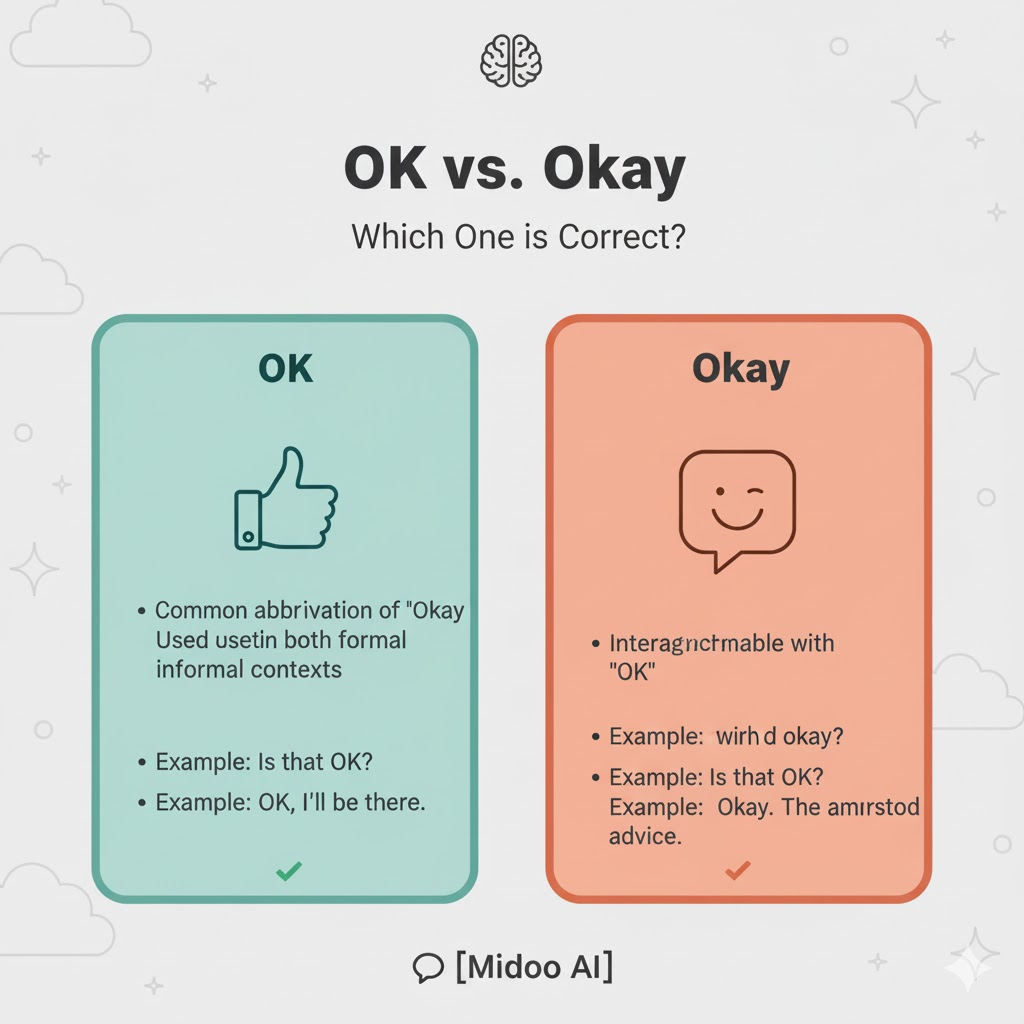OK vs. Okay—Which One Should You Use?

If you’ve ever wondered whether you should write OK or Okay, you’re not alone. Both forms are everywhere—from text messages to business emails—and even native speakers debate which one looks “more correct.”
At Midoo AI, we love helping English learners understand these small but confusing details. Today, we’ll look at where OK came from, how it differs from Okay, and when each version fits best.
1. The Short Answer
Both OK and Okay mean the same thing. You can use either one to express agreement, approval, or readiness.
Examples:
- OK, I’ll be there at 6.
- Everything looks okay to me.
- Are you OK?
- It’s okay, don’t worry about it.
💡 Tip:
You’ll never be wrong using either form—but the choice depends on tone, formality, and medium (text, email, academic writing, etc.).
2. Where “OK” Came From
The origin of OK is surprisingly fun! It dates back to the 1830s in the U.S., when people playfully abbreviated phrases like “all correct” into “oll korrect.” The joke spelling “O.K.” stuck—and spread fast.
By the early 1900s, OK had become a global symbol for approval and agreement.
3. The Role of “Okay”
As OK gained popularity, people started spelling it Okay to make it look more like a real word rather than an abbreviation. Today, Okay feels slightly softer and more informal, especially in writing or conversation.
Examples:
- That’s okay, I can handle it.
- She said it’s okay to start early.
- Okay, let’s go!
💡 Tip:
Use Okay when you want your writing to sound friendly or conversational. It’s great for texting, storytelling, and dialogue.
4. When to Use “OK”
OK works in nearly every situation, but it’s especially common in:
- Short responses (“OK!” or “OK, got it.”)
- Business or technical contexts (“Click OK to confirm.”)
- Notes, forms, and approvals
Examples:
- Please click OK to continue.
- Is the meeting time OK for you?
- The manager said the report looks OK.
💡 Tip:
OK is more universal and fits better in formal or digital environments (like forms, UI buttons, and reports).
5. OK vs. Okay: Quick Comparison Table
| Use Case | OK | Okay |
|---|---|---|
| Formal writing | ✅ Preferred | ❌ Less common |
| Informal writing | ✅ Common | ✅ Common |
| Text messages | ✅ Very common | ✅ Very common |
| Dialogue / friendly tone | ✅ Fine | ✅ Slightly warmer |
| Buttons / apps / forms | ✅ Standard | ❌ Rare |
6. Style Preferences Around the World
Different style guides have different opinions:
- AP Style (news): prefers OK.
- Chicago Manual of Style: also prefers OK.
- Oxford English Dictionary: accepts both OK and Okay.
- Everyday English users: mix them freely!
💬 Tip:
If you’re writing something formal or published, use OK.
If it’s personal or casual, use Okay.
7. Common Phrases with “OK” and “Okay”
| Expression | Meaning | Example |
|---|---|---|
| OK then | agreement / end of discussion | “OK then, let’s wrap up.” |
| OK with | agree / accept | “I’m OK with your plan.” |
| It’s okay | reassurance | “It’s okay, mistakes happen.” |
| OK, fine | reluctant acceptance | “OK, fine, you win.” |
8. Regional and Tone Differences
- In American English, both “OK” and “Okay” are equally accepted.
- In British English, “Okay” tends to appear slightly more often in casual writing.
- “OK” looks more neutral or mechanical, while “Okay” feels human and emotional.
💡 Tip:
If you’re texting a friend—“Okay” feels kinder.
If you’re replying in a work chat—“OK” is quicker and cleaner.
9. Examples in Real Life
- “Are you OK?” → Direct, clear, to the point.
- “Are you Okay?” → Feels a bit more caring or emotional.
- “Everything’s OK now.” → Used in news or reports.
- “Everything’s okay now.” → Used in conversations or movies.
FAQS
Q1: Is “OK” more correct than “Okay”?
Technically, OK is the original form, so it’s considered more standard. But both are grammatically correct.
Q2: Can I use “OK” in formal writing?
Yes. In professional or academic writing, OK is preferred over Okay.
Q3: Which sounds more natural in texting?
Both! “OK” is faster to type, while “Okay” adds a softer tone.
Q4: What about “O.K.” with periods?
That’s the very old-fashioned version. You might still see it in old books, but it’s rarely used today.
Q5: Are there other forms like “K” or “Okey-dokey”?
Yes! “K” and “Okey-dokey” are ultra-casual forms you’ll hear in friendly chats or jokes, but never use them in formal writing.